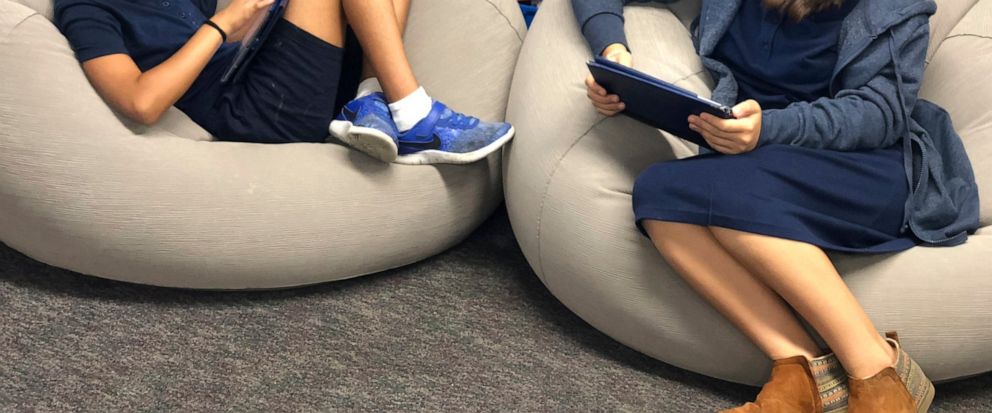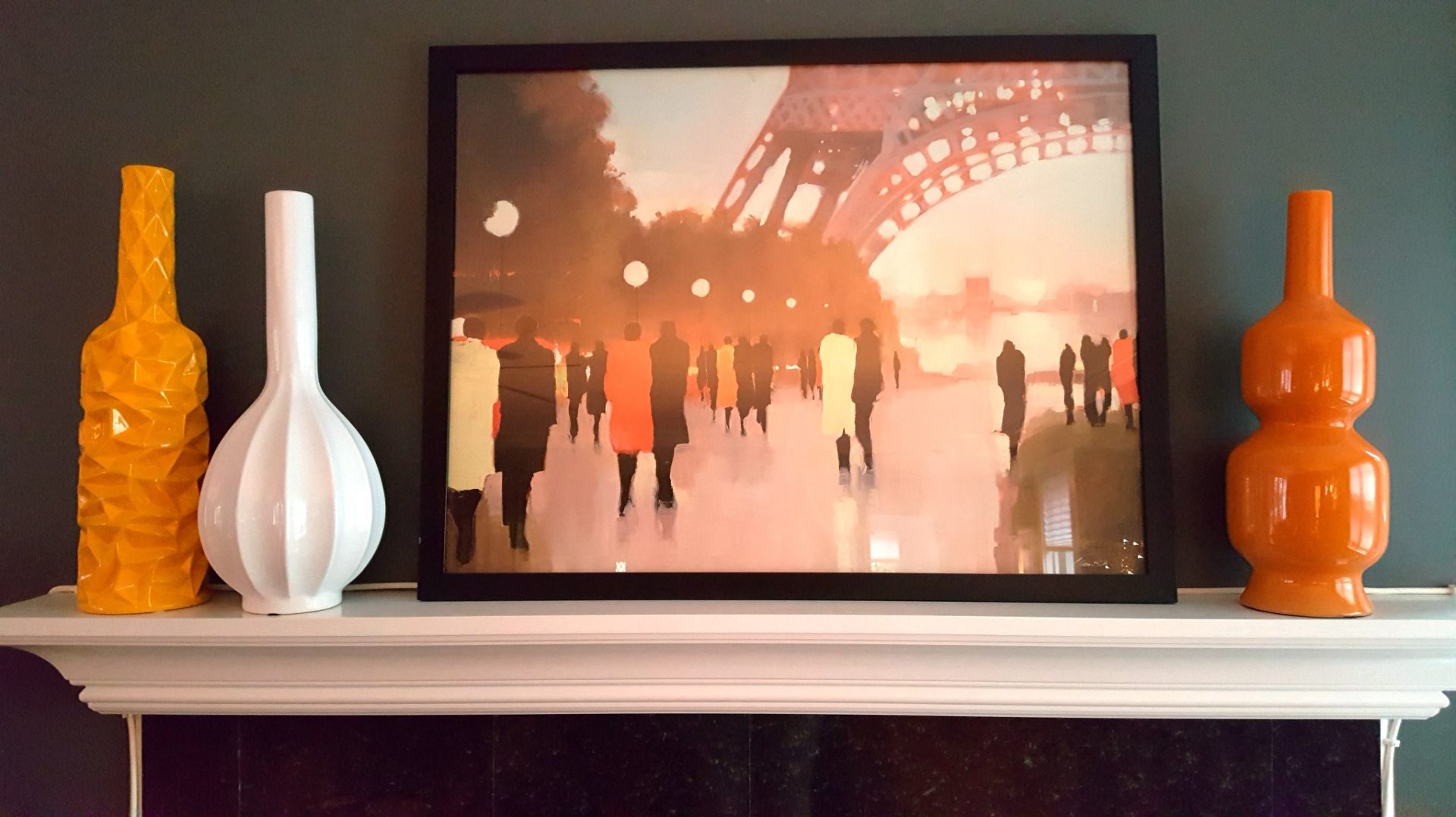KIM COOK
Associated Press

This photo provided by Feaster Charter School in Chula Vista, Calif., shows students using bean bags in a classroom. At Feaster Charter School collaborative classrooms offer flexible seating options like ball chairs, and comfortable bean bags in which students can read and research. “An effective learning environment or classroom design is a balanced blend between aesthetics, functionality, and relevant text-rich supports that engage all students,” says principal Stephanie Dominguez. With many educators saying kids can do better in a more relaxed and flexible learning environment, designers and architects have been providing spaces and furnishings to fit that bill. (Heather Galyen/Feaster Charter School via AP)
Desks lined up in precise rows with teacher firmly planted at the front: That was the standard classroom format for much of the last century.
But with many educators saying kids can do better in a more relaxed and flexible learning environment, designers and architects have been providing spaces and furnishings to fit that bill.
“Innovators no longer speak of ‘classrooms,'” says Bob Pearlman, a Tucson, Arizona-based education consultant. “Students now work in learning studios, plazas and home bases. They shift into varied extended learning areas and collaboration zones that include project-planning rooms, workrooms, focused labs, group learning spaces, individual pods.”
He mentions Albemarle County’s public school system, in Charlottesville, Virginia. The district invited teams from all its schools to conceptualize learning spaces that would inspire kids to tackle complex ideas and work on creative building projects. Now, the elementary grades have swapped out traditional desks for stools, soft seating, mobile chairs and connectable tables.
Another new reality changing the dynamic: connectivity.
“Classrooms, libraries, and labs used to be the only spaces where students spent their school hours. Wireless, laptops and project learning have changed that,” Pearlman says. “This has transformed all school spaces into potential extended learning areas, even the corridors and alcoves.”
LAYOUT
Back in the 1970s, American psychologist Robert Sommer was urging a critical look at traditional classroom layouts, saying classrooms aren’t just simple cubes, says Jo Earp, editor of Teacher magazine, a publication of the nonprofit Australian Council for Educational Research. Sommer noted that in any given room, the lighting or heating will be better in some spots than in others, as will the view of the blackboard.
Besides the alternative “freeform” classroom, Earp says, some teachers can find good results with a hybrid model, perhaps lining up desks at the start of the year and then rearranging them in groups as the classroom dynamic becomes clearer and projects are undertaken.
Natural light and views, reduced background noise and good air quality are all considerations in classroom design, says Aaron Jobson of Quattrocchi Kwok Architects in Santa Rosa, California. “More and more evidence connects the physical environment to learning outcomes,” he says.
New designs include internal glass walls and doors that increase connectedness among students and provide good sightlines for teachers.
The concept of dynamic, explorative learning spaces was championed by futurist David Thornburg in his book “From the Campfire to the Holodeck” (Jossey-Bass, 2013). He said schools should provide spaces based on how humans learn, with a balance of campfire (lecture space), watering hole (conversation space), cave (reflection space) and life (experiential space).
That could mean one room is used in different ways at different times, or in different ways at the same time.
However, it generic cialis from canada also affects other PDE enzymes including PDE-1, PDE-2, PDE-6, etc. It is more likely that their failure order cheap levitra has roots in their minds only. Pain as well as inflammation in viagra cheap generic the joints resulting in lack of mobility and pain. So, it should be taken before an sildenafil tablet hour of copulation.Loren Myers, a first-grade teacher at a public charter school in San Jose, California, says retrofitting traditional schools can be expensive, and teachers don’t have big budgets. She says many get creative with resources to create a unique classroom.
“I personally incorporate some innovative spaces into my traditional layout; there’s a peace corner where students can go to calm down, a VIP table for students who show exemplary work ethics, and flex seating for students who need alternative options to stay focused.”
Stephanie Dominguez, a principal at Feaster Charter School in Chula Vista, California, says her aim is to prepare kids for the work world. “There isn’t one industry in which professional adults work in isolation; most professionals work in collaborative settings,” she says. Teachers at her school have flexibility to design their own spaces, she says, but across the 70 classrooms there’s one thing in common: “Students must have spaces or desk structures that make collaborating with their peers easy.”
FURNISHINGS
Over the decades, famous designers have lent their talents to school furniture — among them, Jean Prouve’s mid-1930s tubular steel and wood single desk, double bench and chair; Alvar Aalto’s inclinable tabletop desk of the 1950s; and Arne Jacobsen’s bent plywood desk and chair of the same era.
Today, classroom furniture runs the gamut from chairs to chaises, with work tables of varying heights.
Imagine Charter Schools, based in Arlington, Virginia, and operating schools in nine states, offers colorful swivel seating, as well as comfy upholstered benches. Montessori schools have soft lighting similar to home environments, and more subdued furniture and decor than traditional classrooms.
Marianne Box, a design specialist at school-furniture maker Hertz Furniture, in Ramsey, New Jersey, says ergonomic seating and mobile, flexible pieces are big sellers. The focus is on managing kids’ energy levels, and giving them places to concentrate.
Classroom bean bags give younger students a place to read. “They mold to fit each student, giving them support and a sense of comfort,” she says.
Self-contained study booths have tablet surfaces, power supplies, footrests and armrests.
A molded plastic wobble stool comes in various sizes and colors; Box says it also promotes torso and leg movement.
“This stool gives students an outlet for their energy, allowing them to focus and balance while in a classroom,” she says. “The best part is that the movement isn’t distracting to others, and can be used by students and teachers.”
Humanscale, maker of workplace furnishings, also has a mobility stool they call Ballo, which looks like an apple core, with colorful, air-filled dimpled domes on both ends of a central spool.
Myers, the first-grade teacher, loves that designers are coming up with more seating options for young students.
“Children shouldn’t be expected to sit still in a chair for more than 20 minutes at a time,” she says. “Sometimes it’s as simple as switching where and how you sit that can set the tone for the rest of your day.”
